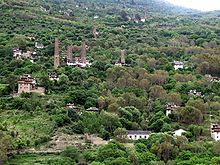Diaolou
Diaolou ( Chinese 碉樓 / 碉楼 , Pinyin Diāolóu ) are fortified residential towers with up to nine floors, which were built to protect against looters and thieves. They are mainly found in the southern Chinese district-free city of Jiangmen in the southern Chinese province of Guangdong . They are mainly found in Kaiping City , but also in Enping , Taishan, and Xinhui District . They also occur in the province of Sichuan : in the northwest of the province in the district of Rongzhag or Rongxar (Dānbā 丹巴 县), in the Garzê autonomous district of the Tibetans and in the north of the province in Zhibo (district of Barkam (Chinese: Ma'erkang xian) , Ngawa Autonomous District of Tibetans and Qiang ). In Guangdong, the Diaolou are seen as an example of the Lingnan culture .
The Diaolou were built by relatives of wealthy overseas Chinese - many of whom came from Guangdong - or by them themselves after their return. The first residential towers were built at the beginning of the Qing Dynasty ; its heyday - triggered by the Taiping uprising - was between 1860 and the 1920s and -30s. Many of them were destroyed, demolished for building materials, or neglected during the Cultural Revolution . However, over 3000 buildings of this type have been preserved. In Kaiping alone there are around 500 in Taishan in 1833.
Typical of the Diaolou are largely unadorned lower floors with regularly arranged windows, crowned by a cantilevered, palatial roof floor - often with loggias and terraces. The building is often accessed via an outside staircase. Particularly on the roof floors, but also in the overall decor, there are clear echoes of the architectural styles of the host countries, especially the Renaissance and Baroque . Most of the Diaolou preserved today (from the 20th century) were made of reinforced concrete and secured with steel doors, some with cannons and searchlights.
The most famous Diaolou include: Ruishi lou瑞 石 楼 (behind Jinjiangli village, Xianggang), built in 1921 , the tallest of all with nine floors; then the Fangshi Denglou方 氏 灯 楼, built in 1920 , eight floors with a spotlight on the top like a lighthouse ; the Bianchouzhu Lou ("the Leaning Tower"), built in 1903 in Nanxing Village, next to a pond, seven stories high; the Li Garden, in Beiyi Xiang, built in 1936 by Xie Weili, a Chinese who emigrated to the USA.
List of listed monuments
The Diaolou of Kaiping (Guangdong) have been on the list of monuments of the People's Republic of China (5-502) since 2001 and on the UNESCO list of World Heritage Sites since 2007 .
The Diaolou in Zhibo Village (Sichuan) in Barkam County (Ma'erkang xian 马尔康 县) (Zhibo diaolou 直 波 碉楼) have been on the list of monuments of the People's Republic of China (5-384) since 2001 .
The Diaolou in Rongzhag County (Chin. Danba , Sichuan) (Danba gudiaoqun 丹巴 古 碉 群) have been on the list of monuments of the People's Republic of China (6-697) since 2006 .
literature
- Li Yuxiang: Kaiping diaolou yu minju ( Diaolou and folk dwellings in Kaiping ). Nanjing: Jiangsu meishu chubanshe, 2002 (Lao fangzi); ISBN 7-5344-1266-8
Web links
- The Kaipinger watchtowers
- Kaiping Diaolou and Villages - UNESCO World Heritage Center - English
- Deep gorges and one last pass in Western Sichuan - English
- The Diaolou of Kaiping (1842-1937) - English
Footnotes
- ↑ Archived copy ( memento of the original from October 9, 2007 in the Internet Archive ) Info: The archive link was inserted automatically and has not yet been checked. Please check the original and archive link according to the instructions and then remove this notice.
- ↑ Frankfurter Allgemeine Sonntagszeitung from May 25, 2008
- ↑ kpliyuan.com ( Memento from December 1, 2017 in the Internet Archive )
- ↑ UNESCO World Heritage Center: Kaiping Diaolou and Villages. Retrieved August 19, 2017 .

